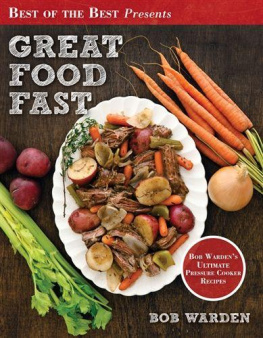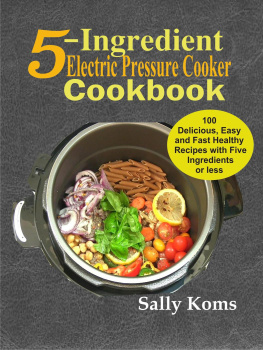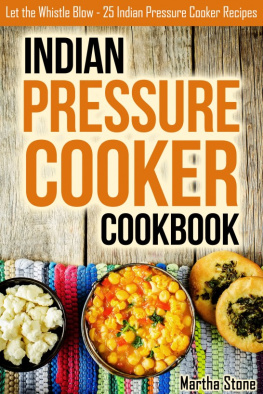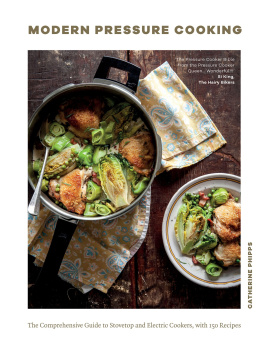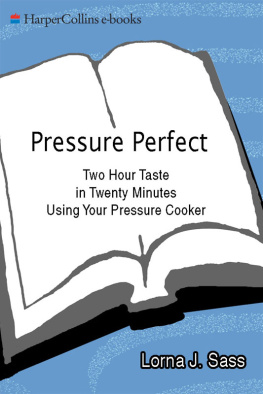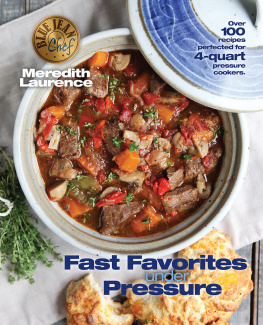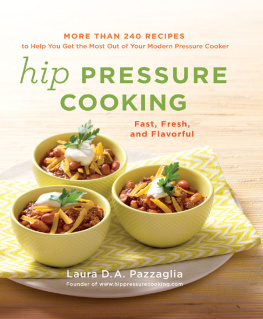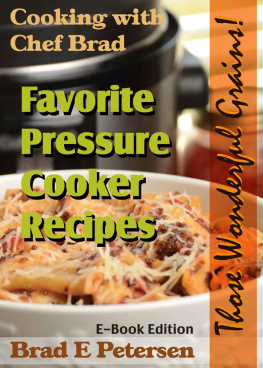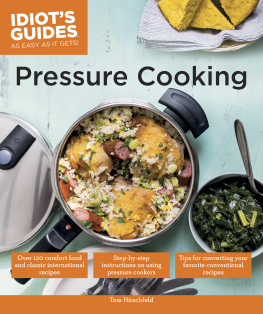Published by Quail Ridge Press and Great Chefs International Copyright 2012 by Bob Warden
All rights reserved. No part of this book may be reproduced in any form without written permission from the publishers. First printing, December 2011 Second printing, December 2011 Third printing, February 2012 Authors: Bob Warden with Christian Stella Author photograph Benoit Cortet Book design and Food Photography by Christian and Elise Stella ISBN 978-1-934193-79-2 Manufactured in the USA Foreword by Gwen McKee When Bob Warden asked me years ago to do a pressure cooker cookbook with him (following our successful collaboration on the Best of the Best Cooks Essentials Cookbook), I respectfully declined due to inexperience. I havent owned a pressure cooker in years, I said. So he sent me one, and he promised Id love it. But as a Louisiana gal who grew up on stove-top sauting and simmering, I was more than a little skeptical.
For those of you who dont already know, Bob Warden is an accomplished chef with cooking experience that spans the globe. He knows, imagines, creates, and/or procures the essentials needed for good cooking. He became my good friend because we both like to cook and eat and because we both love to share what weve learned about cooking with others. The first pressure cooker that I ever used was a wedding present, and it was an old-fashioned stove-top cooker that had one of those little buoy-looking bobbles on the lid. It never failed to cause me fear and trepidation when using it. In fact, it came with warnings from my mother, who wouldnt let my sisters and me get anywhere near her own pressure cooker as we grew up.
These memories stuck with me, and I rarely broke out my wedding present because of it. Of course, before microwaving made thawing a whole lot faster, the pressure cooker was my emergency cookware of choice when dinner was forgotten in the freezer. But when Bob sent me a new and modern cooks essentials pressure cooker, I was like a kid with a brand-new toy! It was so easy to use that, almost immediately, I was turning out great dishes in far less time than even I thought possible. Who would have thought it could make such a difference in my kitchen? With no more fear of that little buoy thing being knocked off and spewing volcanically onto the ceiling, I go boldly forward, understanding why so many people cook with pressure cookers these days. Not only do I enjoy using mine...I am hooked! But lets talk about cookbooks, which just so happen to be my favorite books in the world. Having produced hundreds, I am forever testing recipes, and I know how a great recipe can make you feel like youve stumbled onto something magical.
When it comes to pressure cooking, recipes can help us demystify and deconstruct the process, no matter what our skill set may be. Pressure cooking, like baking, is a science. Its important to use the right ingredients in the right amounts and cook them for the right amount of time, under the right amount of pressure. For these reasons alone, I endorse this cookbook. Bob is very dedicated and thorough in whatever he does, and this cookbook is no exception. The recipes are creative and taste great.
The recipes have been tested, editedand most importantlythey work! If pressure cooking is a science, Bob is one of those teachers who is so down to earth that he can make you forget all about that... he can make you feel empowered in the kitchen. This cookbookespecially Bobs directions and tipsshould help take the pressure off your pressure cooking. I know it did for me. Introduction Demystifying Pressure Cooking As Gwen just touched on in the preceding Foreword, pressure cooking has come a very long way in recent years. No longer do we need to worry about the confusing and sometimes frightening stove-top pressure cookers and their tendency to burn food when not watched carefully enough.
Today, digital pressure cookers can literally take all of the pressure off of this great (and extremely fast!) way of cooking. I like to think that my last pressure cooking cookbook, Slow Food Fast, helped demystify pressure cooking even further. I had been presenting the ease of pressure cookers on TV for years, but I soon realized that I needed to compile a cookbook that gave the clearest and most concise directions for delicious food that I could muster. Simply put, too many pressure cooker cookbooks read like technical manuals or textbooks, and nearly all of them contain no photographs whatsoever. Call me old fashioned, but I like to eat with my eyes first! While I had always set out to create the first true companion to the digital pressure cookers I demonstrate on TV, I was still deeply humbled by the success and kind reviews I received for that book.When it came time to sit down and write an all-new pressure cooking book, I decided to take my goal of demystifying pressure cooking even further. I decided to stop and read each and every Internet review, forum, and blog post ever written about my last book and give my fans exactly what they wanted.
I even decided to push the limits of pressure cooking and try things Ive never seen or thought could be prepared that way (like lasagna!). The result is the book you have in your hands. It has been a labor of love more than two years in the making. It contains recipes that I consider to be the best Ive ever written.Theres an element of surprise to pressure cooking. You put everything in the pot, close it up, and let it cook sight unseen. It isnt until youve released the pressure and opened that lid, until youve dipped a spoon in and had a taste, that you truly know what you have.
I can tell you that I am still surprised when I open that lid. Ive tested some of the recipes in this book a dozen times and that momentthat first spoonfulstill gets me. How to Adjust Recipes for PSI While the recipes in this book were written and tested in cooks essentials Digital Pressure Cookers, they can be prepared in any pressure cooker, whether digital or stove top. Some cookers display the cooking pressure in the simple terms of HIGH and LOW, while other cookers display them in psi (pounds per square inch). Most of the recipes in this book are written to be cooked under the highest pressureHIGH on some models of pressure cookers and 15psi on others. The few recipes in this book that are labeled to cook on LOW pressure should be cooked at 7.5psi on cookers that display in psi.
Before using any pressure cooker for the first time, it is highly recommended that you read that cookers manual from front to back to fully understand how to safely and correctly operate it. Quick and Natural Releases When using a pressure cooker, there are two methods to release the pressure after cooking. This book uses both of these methods, depending on the needs of the recipe. A quick release typically involves opening a steam valve to let the pressure escape all at once. A natural release is when you simply let the cooker sit until the pressure naturally dissipates on its own. This natural release process can take up to 15 minutes.
For many cookers, it is not immediately obvious when a cooker has naturally released all pressure, so I usually include how long to let the cooker sit and naturally release pressure before quick releasing the remaining pressure to get the optimum results. For more information on how to perform quick releases with your specific cooker, be sure to consult your manual. I highly recommend using an oven mitt to quick release to keep your hand safe from any hot steam. Loosely placing a towel over the steam valve can soak up the steam and keep it from collecting on your walls or cabinets. About Cooking Times Cooking times at the top of the recipe pages in this book refer to the amount of time the recipes cook under pressure and do not include the time it takes your particular cooker to come up to pressure or the time it may take to brown meats or saut vegetables. It was decided that simplifying the cooking time to the time under pressure will allow you to easily glance at the page and accurately set the timer on a digital pressure cooker.
Next page
